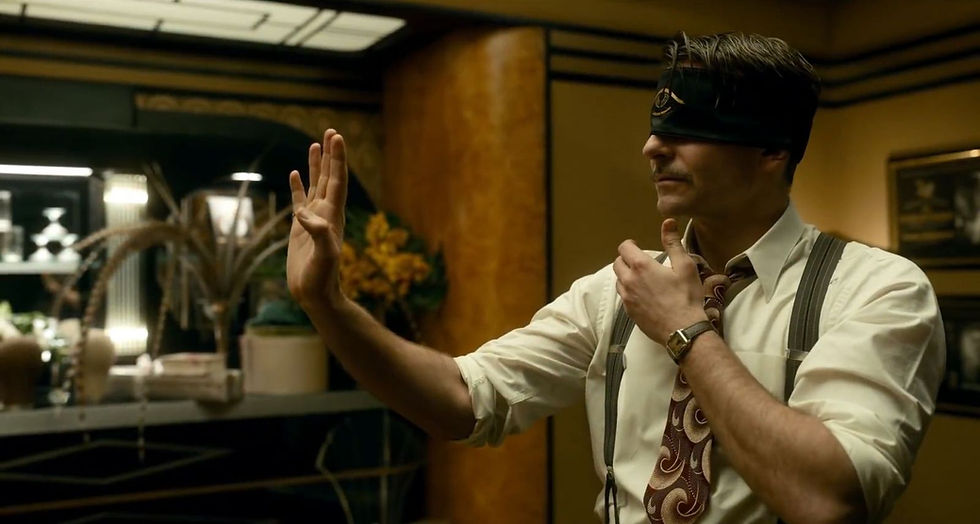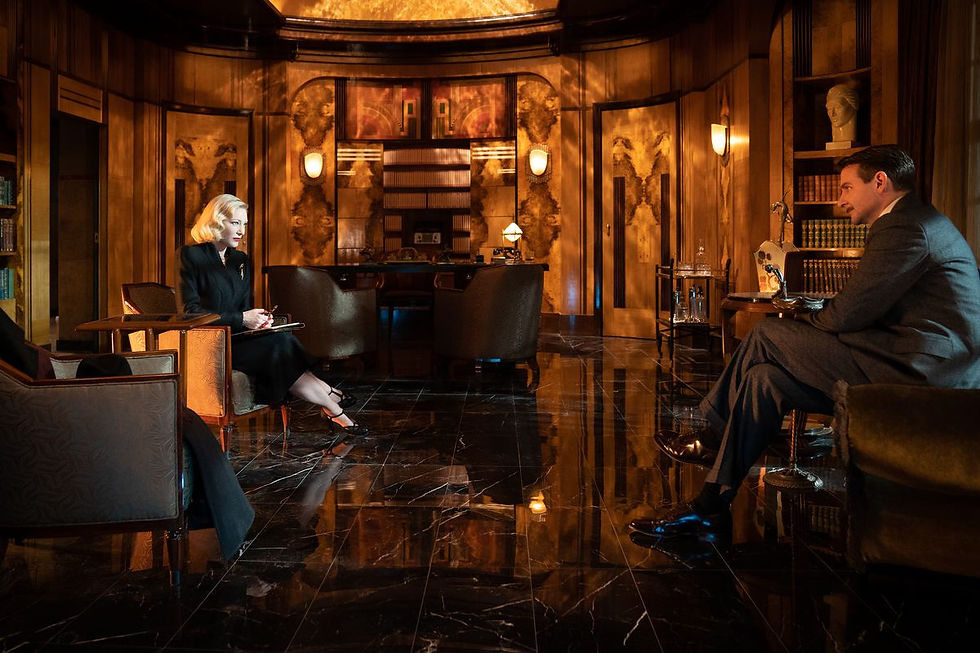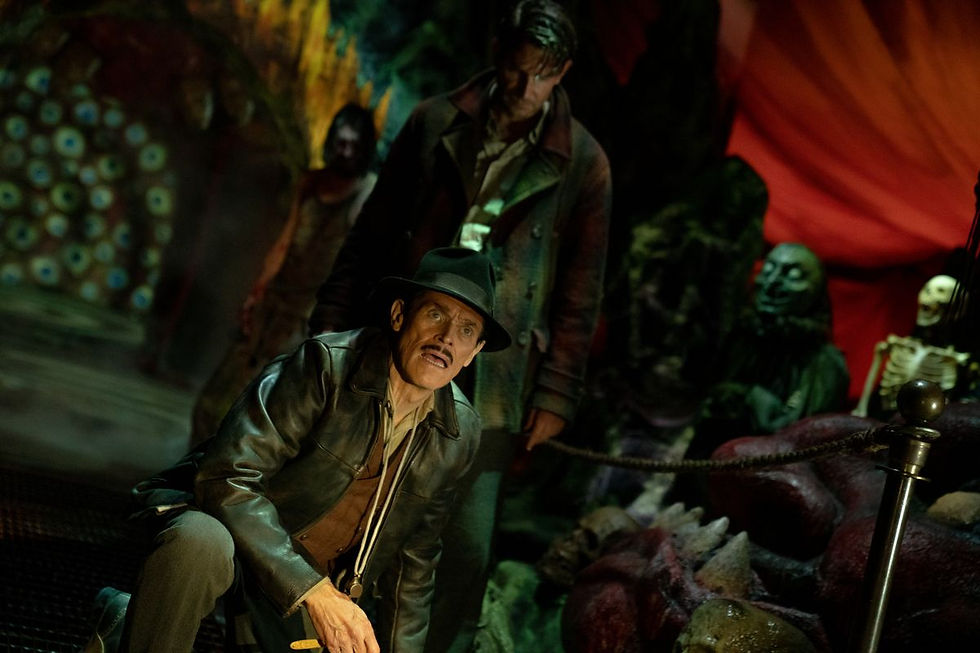Review of "Alley of Nightmares" - a stylish drama by Guillermo del Toro about the vicissitudes of fate and the destructive power of art.
The return of the Mexican classic: this time without mysticism and monsters, but with retro aesthetics, circus performers and mustachioed Bradley Cooper.
A young man named Stan Carlyle (Bradley Cooper) is on the run for no reason: he sets fire to his house and sets off on a long journey across America, until one day he stumbles upon a traveling circus. Having got acquainted with his artists, the hero decides to stay and learn the skill from the fortuneteller Xena (Tony Collette): she pretends to be able to read people's minds, but in fact, together with her alcoholic husband, shamelessly (and skillfully) inflates the crowd. Stan soon learns that the couple used to shine with their other number - with the help of a cunningly compiled cipher, they guessed to the smallest detail which object was in the hands of the audience. Having adopted this technique of mentalism, the hero plans to escape from the musty circus and start a solo career, taking with him the charming Molly (Rooney Mara) - a girl through whom an electric current is passed right on stage.

Nightmare Alley is a movie that is atypical for the director in every sense. Waiting for mysticism, monsters and curses? Get an old-fashioned noir stylization. Would you like to once again listen to the radical criticism of the American dream, Nazism and conservatism? This time, the master will talk to the viewer about the artist's mission and his moral responsibility to the public. The already not very laconic del Toro dared to extend the running time to 2.5 hours (the first adaptation of Nightmare Alley, we recall, was a little less than two), and the dynamic multi-genre nature of the author’s last work, The Shapes of Water, was replaced by outrageous accuracy and restraint, inherent in not just talented, but brilliant directors.
And yet it's the same del Toro we've come to love, just slower and darker than before. For him, this movie has a special meaning: it is about himself, about what surrounds the director (and any other artist) every day, and therefore, perhaps, the most personal. Stan enters the territory of the circus as an inexperienced beginner, but soon tents, iridescent lights and carnival melodies will surround him, turning life into one big industrial fairy tale. Carlisle and his colleagues, of course, are not just wandering artists - they are artists, creators, whose imagination is not inferior, say, to the skill of a painter or actor saves situations with his oratorical talent).

Wade through the stylish baroque, noir noir references and Bradley Cooper's squishy mustache and you'll understand what the film was about. Charming Stan, who went from mediocre beggar to master of the stage and back, is, of course, the alter ego of del Toro himself (and if not an alter ego, then at least an anti-example). How, in essence, does carnival life differ from cinema, and showmen from Hollywood stars? Poor Carlisle, on whom the burden of talent has fallen, and the clairvoyant Xena are the most gifted of all the inhabitants of the circus. Their deceit has a healing, almost therapeutic property: tell people that their dead loved ones are somewhere nearby, and a happy smile will immediately stretch on the face of a downcast layman. Another thing is that in cinema, as in any other skillful fiction, for del Toro there is always a line - artists by nature are obliged to lie, but in no case can they hypocritically play with the feelings of the public.
What is the original by William Lindsay Gresham, what is the adaptation of the 47th, what, finally, the new Nightmare Alley - stories about the deceptive essence of life and art. The philosophy of Tarot cards is intertwined with psychotherapy, carnival everyday life cleverly rhymes with confusing secular everyday life: in this story, on the one hand, everything is predetermined, and on the other hand, it is not completely clear. The film resembles a card trick - by and large an obvious deception, which, however, leaves much more questions than answers. You feel childish delight, realizing all the fiction, but you want to get to the bottom: in the case of this film, the essence of human psychology. Although the characters in Nightmare Alley are perhaps the most talkative in del Toro's entire filmography (at one point, Bradley Cooper even lies down on a Freudian couch and talks about his troubled childhood), the key to their actions will have to be picked up, like the villain from The Devil's Backbone. : painstakingly, to no avail and without outside support.

Toward the end, reflections on the sinister power of art and the complexities of human nature merge together. It's 1941 in the courtyard of Nightmare Alley - while Stan deals with his life, news of the Second World War is heard on the radio, in newspapers and from the lips of passers-by. Guillermo del Toro has always been intolerant of Nazi ideology, but here he allows his hatred to fade into the background: he needs talk about Hitler, the conquest of Europe and bloody battles not for the sake of the historical setting, but for the same dialogue about the artist. Nazi Germany is a product of propaganda, cultural manipulation and deception. Outstanding but misguided geniuses (Lenny Riefenstahl), like Stan, turn their gift against humanity.
That is why Nightmare Alley is del Toro's most pessimistic movie. If in The Shape of Water the characters could communicate through art, here it separates Stan from the whole world. The author's favorite move (to make monsters people, and people - monsters) seems to be looped. The hero of Bradley Cooper, like other white cisgender men in the author's filmography, bleeds, slowly decomposes and turns into a monster. The director will be criticized more than once for self-repetitions, predictability and notorious slowness - the last in the monumentally long Nightmare Alley is really felt when the film crosses the equator. On the other hand, if every director filmed as “boringly” as del Toro does, the world would be a much happier place. The main thing is not to get lost in the local labyrinths of the Faun and not turn into a beast, like Stan - the scenery and costumes of the director, as usual, can distract from the most obvious and important subtexts.
This article was sponsored by Nikolay Ivanov
Comments